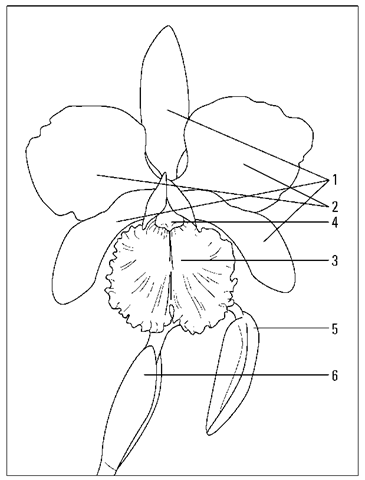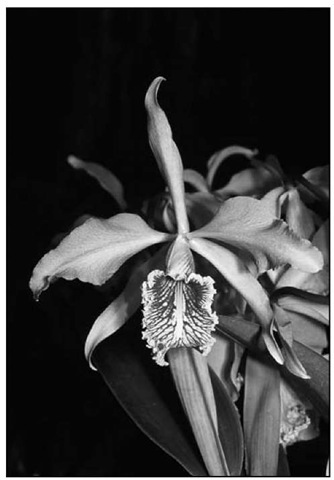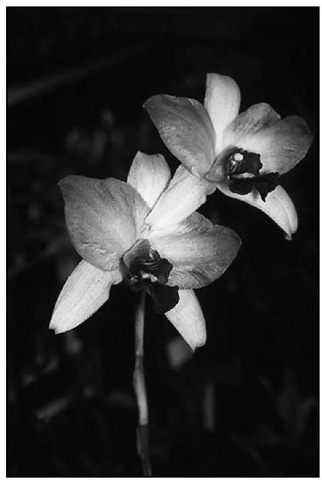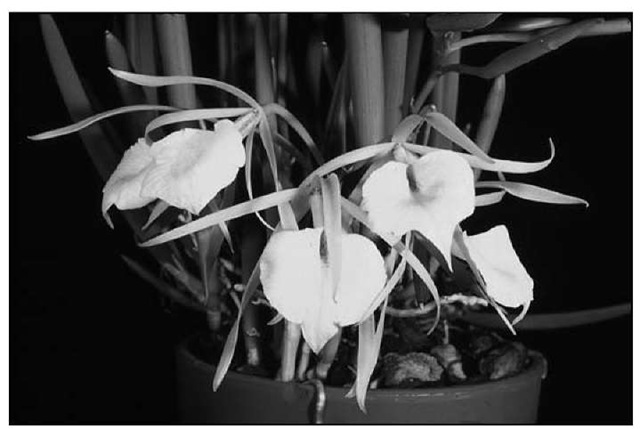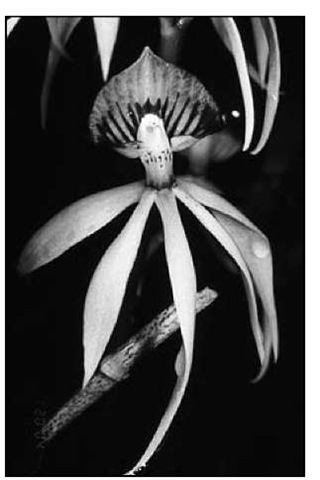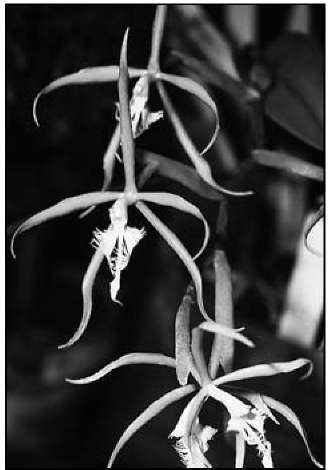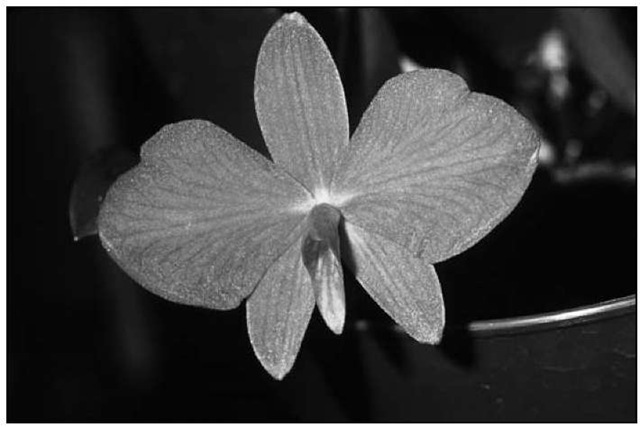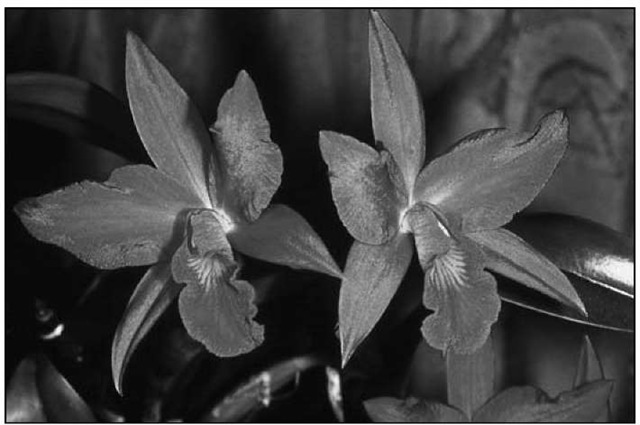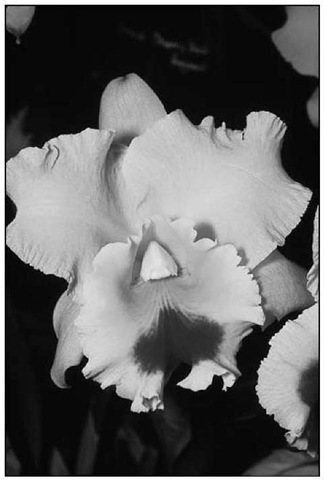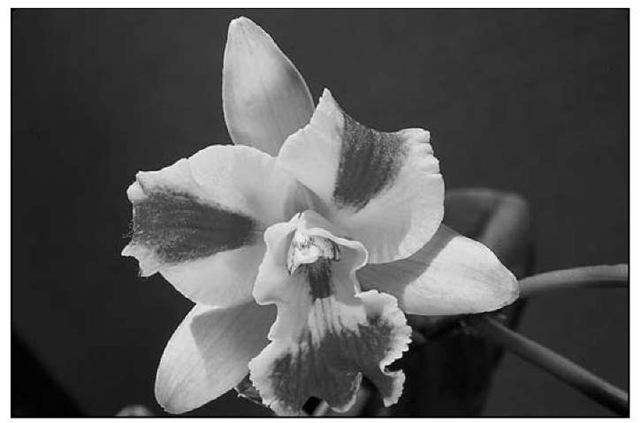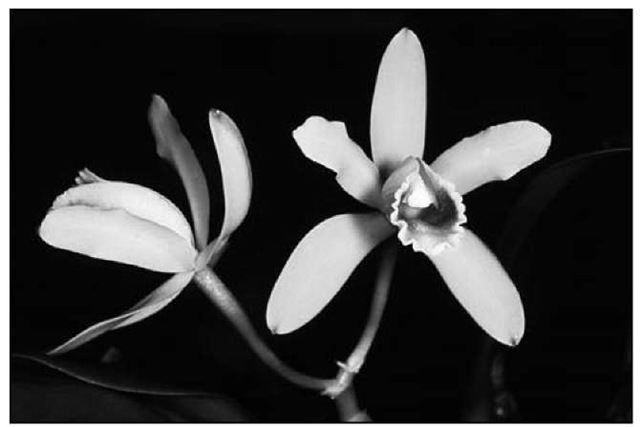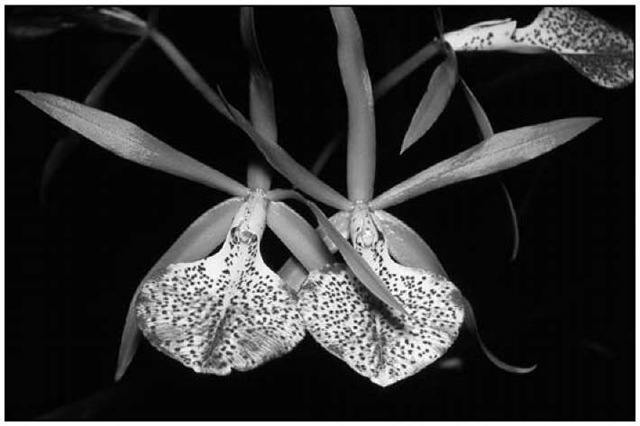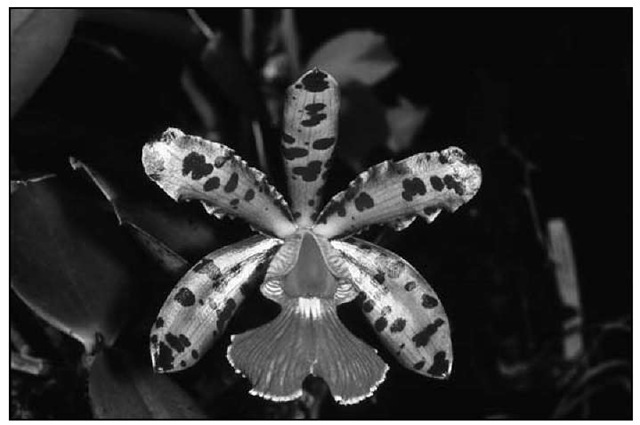In This Topic
- Understanding how cattleyas and laelias made it from nature to your home
- Growing cattleyas’ wild relatives
- Looking at the man-made cattleya orchids
- Discovering small-growing cattleyas, the minicatts
When people picture what a typical orchid looks like, the cattleya flower is usually what comes to mind. Years ago, the ultimate gift to give your mother or grandmother on Mother’s Day was a cattleya orchid corsage. Back then, these were usually fragrant flowers in various shades of lavender.
Until the skyrocketing popularity of the phalaenopsis took off several years ago, the cattleyas were the undisputed kings of orchids. They’re still highly popular, because they offer huge and frequently fragrant flowers, in a complete spectrum of colors and flower shapes, on plants varying in size from a few inches (5 cm) to a few feet (60 cm) tall. To see how the glorious flowers of cattleyas are constructed, see Figure 11-1.
In this topic, I introduce you to a few of the many orchids in this illustrious group that are readily available and easy to grow. You’ll see why they epitomize the beauty and fragrance that only orchids can offer.
Cattleyas grow best in moderate humidity and medium to bright light, with good air circulation, and in intermediate temperatures.
Figure 11-1: The structure of a typical cattleya flower (1 = Sepals; 2 = Petals; 3 = Lip; 4 = Column; 5 = Bud; 6 = Sheath).
From the Jungles to Your Home
In the 1800s, plant collectors and explorers risked their lives and lived in steamy tropical outposts to bring these South American orchids to the plant lovers of Europe. Today, all the best forms are readily available and none have been collected from the wild. Instead, the best cattleyas are raised from seed in laboratory flasks, which is not only good news from a conservation standpoint (they aren’t resulting in destroyed natural habitats from field collecting) but also because these plants are generally stronger and more vigorous than those collected from the wild and adapt better to home-growing situations.
Some selected cattleya species
Some of the cattleya species are a little more of a challenge to grow than the hybrids, so if you want to go right to the easier plants, skip this section and move on to “The Queens of the Ball: Cattleya Hybrids,” later in this topic.
However, if you prefer the simple, classic flower that the species offers, here are some to try that are usually readily available:
- Cattleya amethystoglossa: You’ll need a tall, very bright window to accommodate this orchid, because it can reach 3 feet (1 meter) in height. Its 2>2-inch (7-cm) light pink flowers speckled with purple and highlighted with a purple lip are in clusters of up to a dozen and appear in the spring.
- Cattleya aurantiaca: A longtime favorite with dark green shiny leaves on a compact 12-inch (30-cm) plant, this orchid is loaded with clusters of orange to red, 1)2- to 2-inch (4- to 5-cm) flowers.
- Cattleya bicolor: Clusters of 3-inch (7.5-cm) coppery to pinkish-brown, waxy, spicy-scented flowers with contrasting bright-pink lips that appear in the spring make this species a standout. The plant grows to about 20 to 36 inches (50 to 85 cm) tall. Repot this orchid only when new roots are starting to develop.
- Cattleya guttata: This orchid is very similar in most respects to Cattleya amethystoglossa, except that it blooms in the summer and fall.
- Cattleya harrisoniana (see Figure 11-2): Pink to deep rose, floral-scented flowers are displayed on this summer or fall bloomer. This plant is best repotted in the spring.
- Cattleya intermedia: A medium-size grower that reaches about 15 inches (40 cm) high with leaves about 6 inches (15 cm) long, this orchid produces sizable, 6-inch (15-cm) sweet floral-scented flowers that are a light pink with a contrasting dark purple lip.
- Cattleya leuddemanniana: Up to five 4)2- to 5-inch (10- to 13-cm) richly purple flowers veined in yellow adorn this floral-scented, spring-blooming plant.
- Cattleya maxima (see Figure 11-3): Loaded with 5-inch (12.5-cm) lavender-pink, baby-powder-scented flowers that display lips with dark purple veins and yellow throats, this fall- to early-winter-blooming orchid is Peru’s national flower.
Figure 11-2: Cattleya harrisoniana has been a longtime favorite cattleya species.
Some tall-growing cattleyas can be very top-heavy, especially when they’re in full bloom. Potting them in squat, azalea-type clay pots that have wider bases and/or putting 1 inch (2.5 cm) or so of clean gravel in the bottom of the pots helps prevent the plants from toppling over.
Figure 11-3: Peru is proud to have the Cattleya maxima as its national flower.
The real truth about flower color
Orchid flower color descriptions in catalogs sometimes reflect more what the breeder or seller of orchids would prefer the flower color to be than what it actually is. When the flower color is described as “yellow,” “pink,” “white,” or “orange,” it’s usually close to this. When the color descriptions drift toward solid blues and clear reds, this is where wishful thinking sometimes takes over. Most “blues” are actually bluish shades of purple or lavender, and most “reds” are actually dark-oranges.
Some selected taetia species
Laelias look very much like cattleyas. In fact, few amateurs are able to tell them apart. One difference: Laelias usually have somewhat of a smaller lip than cattleyas. Laelias are native to the same areas as their close cousins, cattleyas, and have very similar cultural requirements.
Following is a sampling of some of the easier and more beautiful laelias that are worthy of space in your orchid collection:
Laelia anceps (see Figure 11-4): This orchid is a toughie that’s hardy to 20°F (-6.6°C) and is a favorite for growing outdoors in mild parts of California and the southeastern United States. It comes in various color forms but most commonly has clusters of two to six 2)2- to 3-inch (6- to 8-cm) light lavender flowers with darker purple lips and throats. The flower spike can reach up to 3 feet (1 meter), so be sure to give it plenty of headroom when it sends up its flower spikes.
Laelia perrinii: A native of Brazil, this species is not yet commonly found, but it’s sure to increase in popularity because it’s a robust grower, reaching about 14 to 16 inches (30 to 40 cm) in height. It sports lightly spice-scented, fine-quality, lavender flowers measuring up to 6 inches (15 cm) across, with lips that are trumpet-shaped and edged with deep violet with white in the throat. Blue and white color forms are also available.
Laelia pumila: A compact grower that only reaches a height of 8 inches (20 cm), this species is frequently grown mounted on a slab of tree fern or cork. It has a short flower spike with one to two lightly floral-scented flowers that average 3 to 4 inches (8 to 10 cm) across. The entire flower is lavender-colored, sometimes with a darker lip. It comes in other color forms, including a blue one.
Laelia purpurata: This orchid is frequently referred to as the “Queen of Laelias,” because it has the largest and showiest flowers of its genus. This is a glorious plant with flowers that vary quite a bit from plant to plant but generally are about 6 inches (15 cm) across, white, frequently with violet-blue lips (there are various lip colors), and a spicy or anise scent. It needs to be grown on the cooler and drier side during the winter months to bloom best in the spring to summer.
Figure 11-4: Laelia anceps bears its flowers on tall, elegant spikes.
Other cattleya relatives
A slew of other orchid species are closely related to cattleyas and laelias. In the following sections, I tip you off to some good performers from this group.
Brassavolas
You’ll find several excellent brassavola species, but the one that leads the pack because of its popularity and ease of growing (with the same cultural requirements as cattleyas) is Brassavola nodosa (shown in Figure 11-5), commonly called “Lady of the Night,” because of its enchanting and permeating evening fragrance. One to six of its spidery greenish white flowers, from 3 to 6 inches (7.5 to 15 cm) across, are borne on a 6-inch (15-cm) flower stem. It’s a clump-forming orchid that gives its best show when it isn’t divided.
Figure 11-5: Brassavola nodosa is often recommended as a beginner’s orchid because of its ease of culture.
Other brassavolas worth considering are
Brassavola cordata: Has up to 20 lime green, 2-inch (5-cm) blooms with heart-shaped lips. Usually blooms twice a year.
Brassavola cucullata: Has spidery, exotic white to green flowers that are sometimes tinged with yellow or burgundy. Blooms in the summer to fall.
Brassavola flagellaris: Relatively unknown but easy to grow. Its flower is similar in shape and color to the others in this group, but it’s blessed with a wonderful hot-chocolate fragrance.
Brassavola martiana: Its flower is white with a fringed lip and green-yellow points.
Brassavola perrinii: This species has one of the largest flowers of the brassavolas. It usually blooms in the summer but can be variable.
Broughtonia
Broughtonia sanguinea (shown in Figure 11-6) is a small grower, 3 to 4 inches (8 to 10 cm) high, with clusters of 1-inch (2.5-cm) reddish-purple, pink, magenta to crimson flowers, usually veined in dark purple on an 8- to 16-inch (20- to 40-cm) stem. This orchid blooms in the summer and likes a very bright spot. Water and fertilize it regularly during its peak growth in the summertime.
Figure 11-6: Broughtonia sanguinea is a charmer native to Cuba and Jamaica.
Encyctias
This group contains some of the easiest of all orchids to grow and bloom. Many of them are also fragrant.
Encyclia adenocaula: Most encyclias are shades of green and white with some purple markings. This Mexican beauty is different, with rosy-pink to magenta, star-shaped flowers that are borne on long branched sprays.
Encyclia cochleata (see Figure 11-7): Commonly called the “cockleshell” or “clamshell” orchid because its upside-down flower lip looks like one, this unique-looking orchid is very easy to grow and often blooms several times a year. The lip is streaked with purple, while the rest of the spidery shaped flower is lime green.
Encyclia cordigera: Not only is this species considered to be one of the handsomest in the encyclia group, it also fills the air with the fragrance of vanilla. It displays clusters of deep maroon flowers with bright pink lips. The plant is modest in size and grows 12 to 15 inches (30 to 37 cm) tall. See the color photographs in the center of this topic for an example.
Encyclia fragrans: The flower of this very-easy-to-grow orchid is a 2-inch (5-cm) subtle green with purple stripes in the lip. This orchid is so well-liked because it’s so easy to grow and bloom and because it emits a heavy gardenia fragrance.
Encyclia radiata (see Figure 11-8): The subtle creamy white, cockleshell-type flowers with purple stripes in the lip, borne in clusters, are not what make this orchid so popular — though they could be. Instead, its ease of growing and blooming and wonderful fragrance — which has been variously described as smelling spicy-floral or like coconut cream pie, lilac, cinnamon, and hyacinth — are what keep people coming back to this orchid.
Encyclia tampense: A Florida native that is hardy as far north as the central part of the state, this encyclia has green flowers overlaid with brown with white lips marked with purple blotches. It emits a sweet scent when it flowers in the summer.
Figure 11-7: Encyclia cochleata is recommended as an ideal beginner’s orchid because it’s so easy to grow and blooms on an almost constant basis.
Figure 11-8: The claim to fame of the Encyclia radiata is its sweet-scented flowers.
Epidendrum
This group is filled with very brightly colored members and some have a very strong resemblance to encyclias.
Epidendrum ciliare (see Figure 11-9): The 3- to 6-inch (7.5-to 15-cm) lime-green petals of this orchid are set off by its exquisite white fringed lip. The plant reaches about 16 inches (40 cm) tall and is said to have the fragrance of grapefruit.
Epidendrum difforme: This orchid has glossy green flowers about 1X inches (3 cm) on short spikes with a medicinal scent.
Epidendrum cinnabarinum: Bright-orange 132-inch (4-cm) flowers with fringed yellow lips are the main feature of this colorful epidendrum. The flowers are borne in succession, so the plant can be in bloom for months during the summer. This orchid can grow quite tall, up to 4 feet (120 cm), and is often grown in large, mass plantings in semitropical to tropical climates.
Epidendrum stamfordianum: A large, well-grown plant of this type of orchid is something to see. It’s loaded with spikes of hundreds of fragrant, 2-inch (5-cm) yellow flowers painted in burgundy with white and yellow lips. It usually blooms in late winter to early spring.
Figure 11-9: Epidendrum ciliare has a spidery green flower with a delicate white fringed lip.
Sophronitis
The sophronitis genus primarily consists of dwarf-growing plants with oversized red and orange cattleya-shaped flowers that shimmer in the sunlight. If you see any of them at a greenhouse for sale — for example, Sophronitis grandiflora (orange-red, shown in Figure 11-10), Sophronitis coccinea (scarlet), or Sophronitis cernua (orange) — you’ll surely want to buy one.
Figure 11-10: Sophronitis grandiflora is a charming plant, but it can be quite a challenge to grow and bloom. A better choice may be a hybrid that uses one of the sophronitis species as a parent.
But don’t! At least not until you have several years of orchid growing under your belt. These diminutive darlings can be very tricky to grow and bloom. You’re much better off purchasing a hybrid that has used one of these species as a parent (see “Hot reds and oranges” and “Minicatts,” later in this topic). These hybrids are more vigorous, easier to flower, and much less demanding.
The Queens of the Ball: Cattleya Hybrids
A modern, standard-size cattleya hybrid in full bloom is a sight to behold! Thanks to the skill of orchid hybridizers and the breeding willingness of cattleyas and their relatives to participate in this process, the results have been flowers in a breathtaking array of colors and heady fragrances.
Because cattleya breeding has progressed to such a high state of perfection, it’s actually difficult to pick out a bad one. In the following sections, I show you a few of the many outstanding hybrids, arranged by approximate color group.
Pristine whites
White cattleyas are almost as classic as the lavender ones. The modern hybrids have full, round, and fragrant flowers. Here are two old classics that are still popular:
- Brassocattleya Mount Hood: This orchid is a pristine white with a golden-yellow lip and the heady fragrance of vanilla.
- Cattleya Bow Bells: This is another old-timer that you’ll find in the background of many of today’s hybrids. It has fine form and its frilly lip is marked on the inside with a touch of yellow.
Purples, pinks, lavenders, and blues
Purple hybrids have been around a long time. You can’t go wrong in buying any in this color group — they’re all very good to excellent. The blue shades in cattleyas are newer. Most of the purples are fragrant. Here are just a few possibilities:
Brassocattleya Blue Grotto: This orchid is referred to as a blue, but it’s more like a violet purple.
Brassocattleya Norman’s Bay ‘Low’s’ FCC/AOS: Although first introduced in England in 1946, this is still a standard bearer today of purple cattleya breeding and is still used as a parent.
Brassocattleya Pamela Hetherington ‘Coronation’ FCC/AOS:
Named for a family member of the illustrious cattleya breeder, Ernest Hetherington, this is a 6-inch (15-cm) lavender-pink flower with a pink ruffled lip and orange-yellow throat. Its flower is a superb shape and is strongly fragrant.
Cattleya Irene Holguin: This is a lavender orchid with excellent shape and color.
Laeliocattleya Bonanza Queen: A classic 6-inch (15-cm) lavender with gold veins in the throat.
Iwanagaara Appleblossom: This hybrid has a complicated history. It’s the result of using various different genera for parents, four to be exact — brassavola, cattleya, diacrium, and laelia. The result is a hybrid with elegant sprays of sweet-smelling, 3/2-inch (9-cm) light-pink flowers with darker pink markings and gold in the throat. A Hawaiian family, Iwanaga, was the first to create a hybrid using these genera, so this is how this new genus got its name.
Hot reds and oranges
Most of the red hybrids are compact growers because a frequent parent in these is one of the sophronitis, which are both red and very dwarf. Here are some to look for — either as plants you’ll grow, or in the parentage of the plants you’re considering:
Sophrolaeliocattleya Jewel Box ‘Scheherazade’ AM/AOS (see Figure 11-11): An older hybrid that is still popular today because of its manageable size, clear red flowers, and easy culture.
Sophrolaeliocattleya Jewel Box ‘Dark Waters’: Another popular one that is a very dark red clone.
Brassolaeliocattleya Oconee: A large-flowered orchid, with fragrant, red-purple flowers with a dark red lip.
Brassolaeliocattleya Edisto: Large purple-red, with up to five flowers per stem. This is a fall bloomer.
Brassolaeliocattleya Owen Holmes ‘Mendenhall’ AM/AOS: Considered one of the best of all reds, it’s frequently used as a parent to pass its superior coloring to its offspring. A good choice.
Sophrolaeliocattleya Hazel Boyd: Another winner with various bright-orange tones and excellent plant vigor.
Cattleya Chocolate Drop ‘Kodama’ AM/AOS: This one has clusters of glossy burgundy flowers with yellow on the column and the fragrance of lily-of-the-valley.
Figure 11-11: SophrolaeliocattleyaJewel Box ‘Scheherazade’ AM/AOS still remains a favorite.
Sunny yellows
Fine yellows have been a more recent development. Today’s hybrids range from gold to butter yellow. Some are sold yellow, while others have darker colored red or purple splotched lips. A few names you can look for include the following:
Brassocattleya Goldenzelle ‘Lemon Chiffon’ (see Figure 11-12): A fine example of how far yellow flowers in cattleya hybrids have come, this one sports 6-inch (15-cm) lemon-yellow flowers with a splash of deep red on the lip. This is a winter bloomer.
Brassocattleya Formosan Gold: Its dark-red ruffled lip provides a dramatic contrast with its golden-yellow petals and sepals that have a spread of about 4)2 inches (11 cm) across.
Brassocattleya Malworth ‘Orchidglade’ FCC/AOS: Highly awarded and one of the best known yellows.
Laeliocattleya Lorraine Shirae: A bright yellow with a contrasting red lip.
Potinara Twentyfour Carat: A large, handsome, clear gold-yellow.
Potinara Haw Yuan Gold: The Taiwan orchid breeders have been making notable contributions to the cattleya group, and this award-winner with its 6-inch (15-cm) bicolor bloom — yellow petals and darker yellow lip — is one of them.
Figure 11-12: Brassocattleya Goldenzelle ‘Lemon Chiffon’ AM/AOS is a gorgeous soft lemon-yellow that demonstrates well the advances in breeding. This one is a frequent winner at orchid shows.
Cool greens
There is something refreshing about lime-green flowers. They have their own following of orchid lovers. Some of their flowers have very fringed lips, usually inherited from the species Rhyncholaelia digbyana (formerly know as Brassavola digbyana). This unique species is also noted for its strong fragrance. Some of the greens have clear-colored flowers, while others are blotched in purple. Here are some choices to consider:
Brassocattleya Greenwich: This cross was made in the late 1960s but still shows up in today’s offerings. The flower is about 4 inches across with purple markings on its fringed lip.
Brassocattleya Ports of Paradise ‘Emerald Isle’ HCC/AOS: One of the most awarded of the greens, this orchid offers large lime-green flowers, a strong fragrance, and a ruffled lip.
Brassocattleya Rio’s Green Magic (see Figure 11-13): This hybrid shows, with its deeply fringed lip, the influence of the species Rhyncholaelia digbyana. It has large, 5-inch (13-cm) flowers.
Figure 11-13: Brassocattleya Rio’s Green Magic offers unique beauty and a sensuous fragrance.
Bring out the clowns: Splash petals and flares
This group is commonly called “clowns” because of the sense of gaiety their wild color combinations impart. They’re marked with two or more splashes or flares of contrasting colors, and the results can be quite dramatic.
Cattleya intermedia var. aquinii: This is the orchid that really started it all. It was the first one that displayed flares of color in the petals and lip, so it was used extensively in hybridizing to pass this quality on to its offspring. In this case, the coloring was purple flares on white petals and the lip. This variety is sometimes offered for sale these days but is more frequently found in the parentage of many of the newer splash petals and flares.
Brassocattleya Momilani Rainbow: A real showstopper with 6-inch (15-cm) flowers and light lavender-pink sepals, dark pink petals, and lips with bright splashes of lemon yellow on them.
Laeliocattleya Colorama ‘The Clown’: Another old classic that has proven invaluable as a parent for future splash-petaled varieties, this orchid has white petals and purple flares with a larger flower than Cattleya intermedia var. aquinii.
Laeliocattleya Gaiety Flambeau: A more modern hybrid that has large clusters of white flowers with purple flares.
Laeliocattleya Mari’s Song ‘CTM 217′: This is one of the best and most popular tricolored, splash-petaled varieties. It has a yellow and white flower with magenta flares and lip with pink sepals and a yellow throat. What a grand color combo! On top of that, it’s very fragrant.
Potinara Barana Beauty ‘Burana’ HCC/AOS (see Figure 11-14): A compact grower that reaches about 12 inches (30 cm) tall, its 3)2-inch (9-cm) citrus-scented flowers are a yellow-green with red flares. Frequently blooms twice a year.
Figure 11-14: Potinara Barana Beauty ‘Burana’ HCC/AOS offers clusters of citrus-scented green flowers with red flares.
Fashionable art shades
This is a catchall category that includes cattleya-type hybrids that combine a range of pastel colors. Here are a few of the many nice ones:
Brassolaeliocattleya George King: A salmon-peachy, fragrant, 6-inch (15-cm) flower with crystalline texture and the fact that this one often blooms more than once a year make this a popular selection.
Brassolaeliocattleya Harlequin ‘Act II’: Another flower with a mixed palette of colors including peach, yellow, and purple flares. A sumptuous beauty. See the color photographs in the center of this topic for an example.
Brassolaeliocattleya Hawaiian Avalanche (see Figure 11-15): This orchid shows off a delightful display of tropical color with the 6-inch (15-cm) apricot-pink flowers with a golden-orange fringed lip and purple streak down the center of the lip.
Figure 11-15: Brassolaeliocattleya Hawaiian Avalanche provides a riot of color. In this close-up of the lip, you can get an idea of the play of color and patterns.
For standard cattleyas, purchasing clones is usually your best bet.They’re very reasonably priced, you’ll know exactly what they’ll look like, and their flowers will usually be superior to the standard hybrids.
Minicatts
There is a revolution going on now in cattleya breeding! Small is in — at least in plant size. Although there is no denying that full-size cattleyas in bloom are impressive, unfortunately they also take up a lot of growing space. And for windowsill and under-light growers, where every square inch counts, this creates a problem. This is where minicatts (short for miniature cattleyas) come in.
They have no special cultural requirements that differ from the standard, full-size plants: Because they’re commonly planted in small clay pots, they tend to dry up more quickly than the larger plants in bigger pots, so you need to keep a sharper eye on your watering to make sure they don’t get too dry.
The key players
These are the species with miniature to small growth habits that have been the principal contributors to this breeding effort. Each of these species is popular in its own right, but each has also been even more important for contributing its desirable characteristics to future orchid generations:
Brassavola nodosa: For more information on this orchid, refer to the “Brassavolas” section earlier in this topic. This popular species added its small size, spidery flower shape, and evening fragrance to the minicatt gene pool.
Cattleya aclandiae: A little dazzler with 3- to 4-inch (7- to 13-cm) yellowish-green to brown flowers covered with purple spots and accentuated with a magenta lip, this is not an easy species to grow. Stick to its hybrids to get the visual effects of the species without its demanding cultural requirements.
Cattleya luteola (see Figure 11-16): This is a darling plant that only reaches 5 to 7 inches (12 to 17.5 cm) tall, making it perfect for small spaces. Its fresh, floral-scented, 2-inch (5-cm), pale yellow flowers with a darker lip are borne in sprays of two to five in the spring.
Cattleya walkeriana: This diminutive orchid has a lot going for it. It has a miniature stature, making it ideal for growing under lights or on a windowsill. Its rose-purple flowers of heavy substance have a fine shape and an exquisite vanilla and sweet floral fragrance that is strongest in the morning. It’s also found in an alba (white) that tends to have the best flower form.
Laelia briegeri: This is a miniature bright-yellow species that isn’t easy to grow by itself but has been valuable for its color and dwarf growing habit that it imparts to its hybrids.
Laelia pumila: This is another important contributor for it compact growth habit, flower form, and color.
Sophronitis coccinea: The shimmering red color and miniature plant habit made this plant an important link. Refer to Figure 11-12 to see a species, Sophronitis grandiflora, that looks very much like this one.
Figure 11-16: Cattleya luteola is a cutie with a fresh floral scent that is strongest in the morning.
Some of their prized children
Here are some of the many hybrids produced by the parents in the preceding section:
Brassocattleya Binosa (see Figure 11-17): Combines a striking color combination, 3-inch (5-cm) bright-green flower with a white flared lip, dusted with purple speckles, with a sweet spicy evening perfume inherited from one of its parents, Brassavola nodosa.
Brassocattleya Cynthia: An offspring of Cattleya walkeriana, this variety is very compact, has 4-inch (20-cm) full, round-pink fragrant flowers with yellow in the throat. It frequently blooms twice a year.
Cattleya Brabantiae: One of the first hybrids to be made, in the 1800s, this one has Cattleya aclandiae as one of its parents. Its 21-inch (6-cm), thick, waxy, pink, fragrant flowers are spotted with maroon and serve as a backdrop for a stunning white lip and column edged in purple. It only grows to 6 to 8 inches (15 to 20 cm) tall and is still popular today.
Cattleya Peckhaviensis (see Figure 11-18): This orchid shows off purple spotted flowers with a bright-pink lip much like one of its parents, Cattleya aclandiae.
Laeliocattleya Angel Love (see Figure 11-19): An easy-to-grow fragrant orchid that has perfectly formed, 4-inch (10-cm), lavender-pink flowers with a frilled lip and yellow in the throat.
Laeliocattleya Love Knot: Another Cattleya walkeriana child that is a very small grower, with large 4-inch (10-cm), deep-red-purple flowers with a darker lip. This one is also fragrant and blooms twice a year.
Laeliocattleya Mini Purple: An offspring of Laelia pumila and Cattleya walkeriana, this is one of the best known and available of the minicatts. It has lavender flowers with a darker purple lip and is fragrant.
Sophrocattleya Beaufort: A classic that has as a parent Cattleya luteola, this orchid is found in various shades of orange and red. It continues to be used extensively as a parent to produce new miniature hybrids.
Sophrocattleya Crystelle Smith: Frequently winning ribbons at shows because of its fine form and delicious color combinations that can vary from pastel pink to apricot shades with lips of solid yellow or marked with red.
Sophrolaelia Psyche: Another old-timer, this is a miniature with petite flaming orange-red flowers passed on from its sophronitis parent. Fortunately, it’s easy to grow.
Sophrolaeliocattleya Jewel Box: See “Hot reds and oranges,” earlier in this topic.
Sophrolaeliocattleya Mahalo Jack: I’ve enjoyed growing this orchid. It has a solid red flower on a dwarf plant. Most are fragrant and bloom a few times a year.
Figure 11-17: Brassocattleya Binosa ‘Kirk’ AMAOS combines a sweet scent with a striking color combination.
Figure 11-18: Cattleya Peckhaviensis show its spots and bright magenta lip from Cattleya aclandiae.
Figure 11-19: Laeliocattleya Angel Love is a perfectly shaped dwarf Cattleya with a citrus fragrance.
